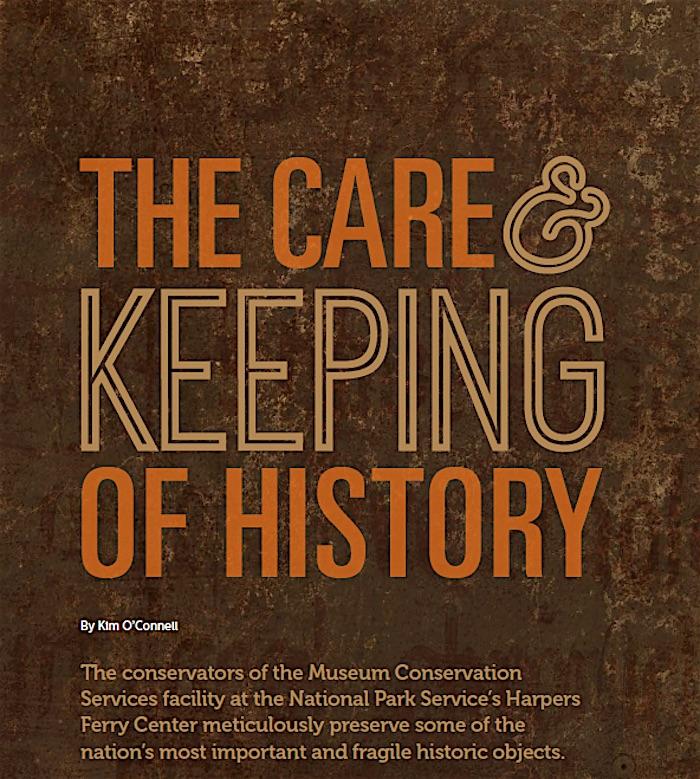
As I enter one of the National Park Service’s conservation labs in Charles Town, West Virginia, I see what look like black shards of various sizes arranged on a large white table.
It’s clear that this artifact has gone through something dramatic and destructive. It was “something involving heat,” Theresa Voellinger tells me with a smile. It turns out that the shards are actually the paper remnants of an old mining claim from Joshua Tree National Park in California. The document arrived at the lab folded up, stiff and brittle and likely to crumble to dust in the wrong hands. But Voellinger—one of the lab’s conservators—was able to tease apart the fragile paper, hoping to stabilize the material so that it could at least be read and recorded.
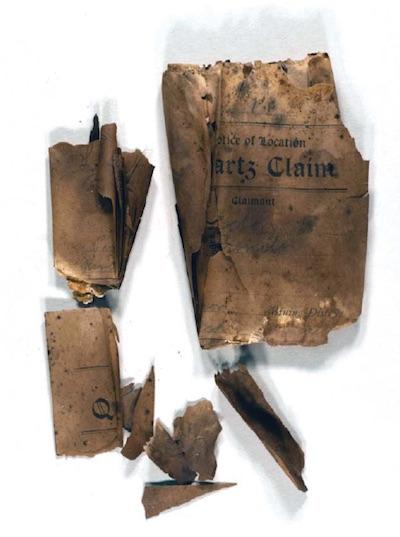
Before (above) and during (below right) treatment images of a mining claim from Joshua Tree National Park. The very fragile claim was gently humidified and coaxed apart by Theresa Voellinger, revealing information that was not accessible before treatment. It will be mended with Japanese paper and housed to make it as safe as possible to handle / NPS photos
Each of the hundreds of artifacts at the lab is a mystery to be solved. Here, the National Park Service employs a team of a half-dozen museum conservators, all who have studied art history, studio art, and chemistry. Many have advanced degrees in art conservation and have served extensive internships in some of the nation’s best-known art and history museums as well as other heritage institutions.
Their workplace, in an unassuming 41,000-square-foot building, is part of the agency’s Harpers Ferry Center, which provides all national parks with interpretive media, planning and project management, and conservation assistance. Although museum conservation takes place in other NPS locations, such as the Historic Architecture Conservation and Engineering Center in Lowell, Massachusetts, the Western Archeological and Conservation Center in Tucson, Arizona, and the National Center for Preservation Technology and Training in Natchitoches, Louisiana, the HFC’s museum conservation lab presently is the most extensive museum preservation facility in the park system.
Although the facility also houses a permanent artifact collection, I’m here to see the conservation lab in action. According to its mission statement, the National Park Service is tasked with preserving nearly 175 million objects, which include documents, books, furniture, paintings, sculpture, clothing, drapery, basketry, leatherwork, weaponry, and much more, and the labs have treated many examples from every category. In addition to the paper labs, the facility includes wooden artifact, books, metal and mechanical arts, decorative arts, ethnographic/natural history, and textile labs. There also is a photographic documentation studio, a large room for applying protective coatings, an analytical lab, and other specialized areas. The facility is not open to the public—although it will occasionally host special tours and school groups—so it is a rare treat to see how some of the nation’s most precious artifacts are preserved.
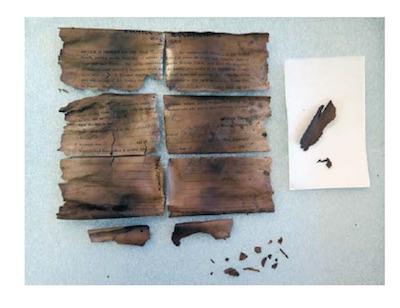
Treatment runs a broad gamut that ranges from non-interventive preventive care to stabilization and restoration. Some objects require surface cleaning or minor mends and repairs, while others require major interventions, such as replacement or reconstruction of missing elements. Conservators write detailed reports of an object’s condition upon arrival at the lab, how it was treated, and recommendations for its future storage or display.
“We can help the parks set priorities for their objects depending on their curatorial value and conservation value,” Voellinger says. Although it’s important that their treatments last, she adds, the team always considers the reversibility of their interventions as well. The field of conservation evolves and new or better treatments might be developed.
In addition to the blackened mining claim papers, Voellinger and Allison Holcomb, a book/paper conservator, show me some of the other paper artifacts currently in their care. They include a 19th-century set of books containing the complete works of Shakespeare, on loan from Fort Larned National Historic Site in Kansas. The covers were once purple and now have faded to tan. For a pocket diary from Little Bighorn Battlefield National Monument, Holcomb shows me a webbed material with which she made a mold that almost exactly duplicated the crisscross pattern on the diary’s leather cover, to repair a missing section.
A special suction table the conservators use to gently hold paper objects in place so they can be bathed to draw out acidic byproducts particularly fascinates me. When Holcomb pulls up an “after” photo of the underlying basin following an immersion bathing process, the water is dark brown—the visual aftermath of decades of decay. Once bathed, very vulnerable documents are sometimes “lined” with a thin and strong paper—usually imported from Japan—that allows it to be read and handled once again.
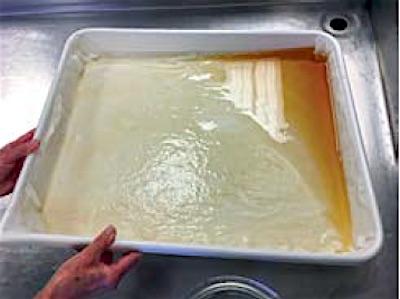
Water after bathing a very acidic paper object. The discoloration removed from the paper comes from acidic components in the paper pulp which darken over time and threaten the stability of the paper. The treatment can make the paper stronger and slow further deterioration/NPS
In the textile conservation lab, Anne Ennes, a longtime textiles conservator, walks the perimeter of a large expanse of red and gold cloth, a curtain from Scotty’s Castle, a historic Mission revival structure within Death Valley National Park in California. The building is currently closed due to flood damage, which has given the conservation lab some time to work on historic objects such as the building’s draperies. They have suffered tears and fading due to many decades of use. Like her peers in the lab, Ennes has crafted a complex treatment solution for the fabric that includes a combination of mending, sheer overlays, and even the digital reproduction of the pattern to help the new interventions blend with the historic material.
Conservators are specialists who often collaborate, I’m told, such as when wooden artifact conservator Curtis Sullivan and metal objects conservator David Arnold might join forces to work on an artifact that includes materials from both specializations. When I visit the metals lab, Arnold is examining an early Springfield military rifle that has a “trapdoor” breech-loading feature that he believes was a prototype or test model manufactured just after the Civil War. Arnold frequently treats firearms and other mechanical arts objects, which can be challenging because, unlike paintings or documents, these objects are usually designed so that most of their vulnerable surfaces are hidden from view and require some disassembly. On this particular rifle, I can clearly see a crack on the outside, which Arnold has made note of and will consider as he develops a treatment plan for the firearm. “Our treatment reports are primarily written for the benefit of the next conservator to review our work—perhaps 100 or more years from now,” he says.
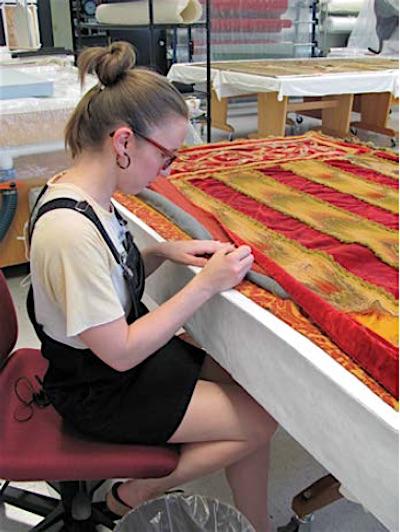
Intern Heather Hodge working to stabilize the curtains from Scotty’s Castle in Death Valley National Park/NPS photo
Over the past 15 years the conservation team has traveled to park sites affected by major disasters, such as Hurricanes Isabel, Katrina, and Maria. On site, the conservators set up a triage system to determine the extent of damage to artifacts, then figure out what can be salvaged, what can be treated on site, and what might be moved to the lab in the future for more complex or long-term treatment. With climate change a growing threat, the lab is having more conversations with coastal park managers, such as those from Cape Hatteras National Seashore or Fort Sumter National Monument, on the potential effect of rising sea levels and dangerous storms on their artifacts.
It’s an evolving field, Voellinger says, and she and her team are excited to be at the forefront of it. “We’re constantly evaluating and re-evaluating how we do things,” she says. “Every object is different and requires its own unique analysis.”
The next time you view a historic artifact in a national park, you just might be looking at their handiwork.



Comments
A dream job.
Great article. These folks do a wonderful job. Really professional and dedicated. Thanks for highlighting their work.